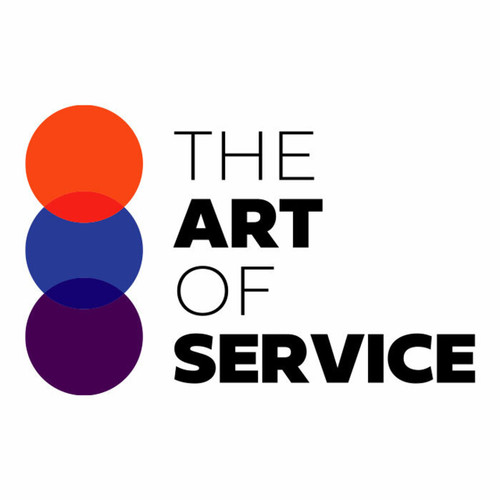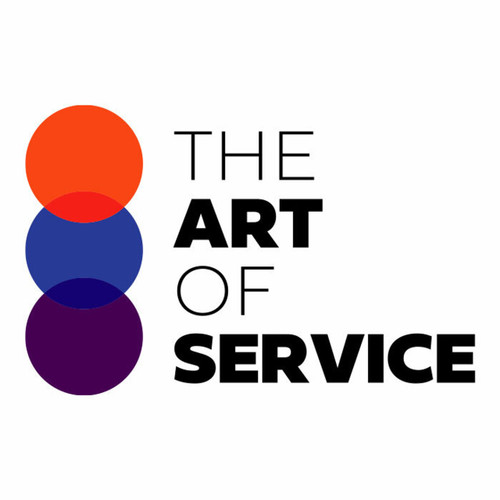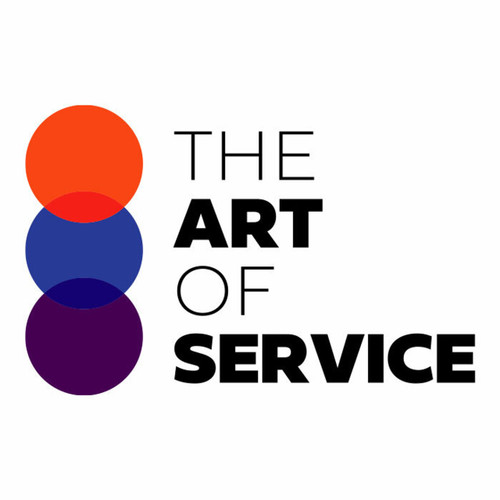Are you tired of sifting through endless regulations and struggling to determine the most urgent and relevant requirements for your industry? Look no further because our Safety Regulations and Failure Mode and Effects Analysis Knowledge Base is here to revolutionize the way you handle safety compliance.
Our extensive dataset contains 1501 prioritized requirements, solutions, benefits, results, and real-world case studies/use cases for Safety Regulations and Failure Mode and Effects Analysis.
This means you have access to the most essential and up-to-date information in one convenient place.
No more wasting hours trying to find the answers you need – our Knowledge Base has got you covered.
What sets our product apart from competitors and alternatives is its comprehensive coverage and user-friendly interface.
We understand that professionals like yourself require a deep understanding of safety regulations and their implications – that′s why we have included not just the requirements, but also solutions and benefits.
Our easy-to-navigate platform allows you to quickly find what you need by urgency and scope, saving you time and effort.
Our product is suitable for professionals and businesses across various industries, making it a versatile and valuable investment.
Whether you′re looking to ensure compliance for your organization or seeking solutions for your clients, our Safety Regulations and Failure Mode and Effects Analysis Knowledge Base is the perfect tool.
With its DIY and affordable product alternative, you have the flexibility to use it as needed without breaking the bank.
Not only does our product provide practical information, but it also offers in-depth research on Safety Regulations and Failure Mode and Effects Analysis.
Stay ahead of the game by staying informed on the latest regulations and industry advancements.
Our Knowledge Base is constantly updated, giving you a competitive edge and ensuring you are always in compliance.
We understand that businesses often struggle with the high costs of compliance.
That′s why we offer our Safety Regulations and Failure Mode and Effects Analysis Knowledge Base at an affordable price, making it accessible to businesses of all sizes.
And with our product, you can avoid the costly consequences of non-compliance.
In summary, our Safety Regulations and Failure Mode and Effects Analysis Knowledge Base is a one-stop-shop for all your compliance needs.
With its extensive coverage, user-friendly interface, versatility, and affordability, it is unmatched in the market.
Don′t waste another minute trying to navigate complex regulations – let our Knowledge Base do the work for you.
Get your copy today and experience the benefits of streamlined safety compliance.
Discover Insights, Make Informed Decisions, and Stay Ahead of the Curve:
Key Features:
Comprehensive set of 1501 prioritized Safety Regulations requirements. - Extensive coverage of 100 Safety Regulations topic scopes.
- In-depth analysis of 100 Safety Regulations step-by-step solutions, benefits, BHAGs.
- Detailed examination of 100 Safety Regulations case studies and use cases.
- Digital download upon purchase.
- Enjoy lifetime document updates included with your purchase.
- Benefit from a fully editable and customizable Excel format.
- Trusted and utilized by over 10,000 organizations.
- Covering: Reliability Targets, Design for Manufacturability, Board Best Practices, Effective Presentations, Bias Identification, Power Outages, Product Quality, Innovation, Distance Working, Mistake Proofing, IATF 16949, Strategic Systems, Cause And Effect Analysis, Defect Prevention, Control System Engineering, Casing Design, Probability Of Failure, Preventive Actions, Quality Inspection, Supplier Quality, FMEA Analysis, ISO 13849, Design FMEA, Autonomous Maintenance, SWOT Analysis, Failure Mode and Effects Analysis, Performance Test Results, Defect Elimination, Software Applications, Cloud Computing, Action Plan, Product Implementation, Process Failure Modes, Introduce Template Method, Failure Mode Analysis, Safety Regulations, Launch Readiness, Inclusive Culture, Project communication, Product Demand, Probability Reaching, Product Expertise, IEC 61508, Process Control, Improved Speed, Total Productive Maintenance, Reliability Prediction, Failure Rate, HACCP, Failure Modes Effects, Failure Mode Analysis FMEA, Implement Corrective, Risk Assessment, Lean Management, Six Sigma, Continuous improvement Introduction, Design Failure Modes, Baldrige Award, Key Responsibilities, Risk Awareness, DFM Training, Supplier Failures, Failure Modes And Effects Analysis, Design for Serviceability, Machine Modifications, Fault Tree Analysis, Failure Occurring, Hardware Interfacing, ISO 9001, Common Cause Failures, FMEA Tools, Failure modes, DFM Process, Affinity Diagram, Key Projects, System FMEA, Pareto Chart, Risk Response, Criticality Analysis, Process Controls, Pressure Sensors, Work Instructions, Risk Reduction, Flowchart Software, Six Sigma Techniques, Process Changes, Fail Safe Design, DFM Integration, IT Systems, Common Mode Failure, Process FMEA, Customer Demand, BABOK, Manufacturing FMEA, Renewable Energy Credits, Activity Network Diagram, DFM Techniques, FMEA Implementation, Security Techniques, Top Management, Failure Acceptance, Critical Decision Analysis
Safety Regulations Assessment Dataset - Utilization, Solutions, Advantages, BHAG (Big Hairy Audacious Goal):
Safety Regulations
Safety regulations refer to policies and guidelines that are put in place to ensure that organizations follow best practices and comply with government-mandated standards to keep individuals safe.
1. Implement regular safety training for employees to ensure compliance with regulations and increase awareness of potential hazards.
Benefits: Improved safety knowledge, reduced risk of non-compliance penalties, and increased safety culture within the organization.
2. Establish a system for regularly reviewing and updating safety policies and procedures to ensure they remain in compliance with changing regulations.
Benefits: Up-to-date and relevant safety measures, reduced risk of non-compliance, and improved safety performance.
3. Conduct assessments and audits to identify any gaps in safety practices and make necessary changes to comply with regulations.
Benefits: Improved safety practices, reduced risk of violations, and increased accountability for safety standards.
4. Collaborate with regulatory agencies to seek guidance and ensure that safety policies and procedures align with current standards.
Benefits: Improved understanding of regulations, potential for exemptions or variances, and proactive approach to compliance.
5. Develop a communication plan to ensure that all employees are aware of safety regulations and their responsibilities for compliance.
Benefits: Increased safety awareness and accountability, reduced risk of violations, and improved safety performance.
6. Utilize technology and automation to track and monitor safety practices, providing real-time alerts and notifications for potential non-compliance issues.
Benefits: Increased efficiency in monitoring and addressing safety concerns, improved record keeping and documentation, and enhanced compliance with regulations.
7. Encourage open communication and anonymous reporting of potential safety violations to ensure timely corrective actions are taken.
Benefits: Early detection and resolution of safety issues, improved safety culture, and reduced risk of penalties for non-compliance.
CONTROL QUESTION: Does the safety policy establish best practices in accordance with governing regulations?
Big Hairy Audacious Goal (BHAG) for 10 years from now:
The safety policy of our organization will be recognized as the global standard for best practices in accordance with governing regulations, ensuring the highest level of safety and protection for our employees, customers, and community. We will achieve this by implementing cutting-edge technology, conducting regular audits and inspections, and collaborating with industry leaders and regulatory agencies. Our goal is to minimize accidents and injuries to zero, establishing our company as a leader in promoting a safety first culture. At the same time, we will continuously evolve and innovate our safety practices to stay ahead of emerging regulations, setting a new benchmark for safety standards in the industry. By 2030, our company will be synonymous with excellence in safety compliance, earning the trust and respect of stakeholders and setting a new standard for organizations around the world.
Customer Testimonials:
"The prioritized recommendations in this dataset are a game-changer for project planning. The data is well-organized, and the insights provided have been instrumental in guiding my decisions. Impressive!"
"This dataset sparked my creativity and led me to develop new and innovative product recommendations that my customers love. It`s opened up a whole new revenue stream for my business."
"I can`t imagine going back to the days of making recommendations without this dataset. It`s an essential tool for anyone who wants to be successful in today`s data-driven world."
Safety Regulations Case Study/Use Case example - How to use:
Introduction:
Safety regulations are an essential aspect of any organization, as they ensure the safety and well-being of employees and customers. As such, it is crucial for companies to establish a safety policy that aligns with governing regulations to promote a safe work environment and compliance with legal requirements. This case study addresses the question of whether a company′s safety policy follows best practices in accordance with governing regulations.
Client Situation:
The client is a manufacturing company that produces industrial equipment used in various industries. The company has been in operation for over 50 years and has recently faced several safety-related incidents, resulting in injuries to employees and damage to equipment. These incidents have raised concerns about the effectiveness of the safety policy and its alignment with governing regulations.
Consulting Methodology:
To evaluate the client′s safety policy and its adherence to governing regulations, the consulting team used a multi-step approach. Firstly, the team conducted a thorough review of the client′s existing safety policy, including all relevant documents, procedures, and forms. This was followed by interviews with key stakeholders, including management, frontline employees, and safety personnel. The team also performed an on-site inspection to identify potential safety hazards and observed the implementation of safety protocols.
Deliverables:
Through the consulting process, the following deliverables were provided to the client:
1. A comprehensive analysis report highlighting the gaps and weaknesses in the current safety policy and its alignment with governing regulations.
2. Recommendations for improving the safety policy and bringing it in line with best practices and regulations.
3. A revised safety policy document incorporating the recommended changes.
4. A training program for employees and managers on the revised safety policy and its implementation.
5. Regular audits and assessments to monitor the effectiveness of the revised safety policy.
Implementation Challenges:
Implementing the recommended changes to the safety policy presented a few challenges for the client. These include resistance from employees who were accustomed to the previous safety protocols, budget constraints for necessary equipment or training, and potential disruptions to daily operations during the transition period. The consulting team worked closely with the client to address these challenges and develop a detailed plan for the implementation of the revised safety policy.
KPIs:
To measure the effectiveness of the revised safety policy and its alignment with governing regulations, the following key performance indicators (KPIs) were identified:
1. Number of safety incidents and their severity.
2. Percentage of employees trained on the revised safety policy.
3. Compliance rate with safety protocols among employees.
4. Budget allocated for safety measures and equipment.
5. Number of regulatory inspections, citations, and fines.
Management Considerations:
To ensure the successful implementation and continuation of the revised safety policy, the management team at the client′s company must remain actively involved in the process. This includes providing the necessary resources and support for the recommended changes, encouraging employee participation and compliance, and regularly reviewing and updating the safety policy as needed.
Relevant Citations:
The consulting team referred to several sources to develop the recommendations for the client′s safety policy, including the Occupational Safety and Health Administration (OSHA) guidelines, relevant government regulations, and industry best practices. In particular, Effective Workplace Safety Committees by the National Safety Council highlights the importance of a strong safety policy that aligns with governing regulations and promotes employee involvement in safety measures. Additionally, The Role of Management in Establishing a Comprehensive Safety and Health Program by the American Society of Safety Professionals stresses the need for top-level management to actively participate in the implementation of safety measures to ensure their success.
Conclusion:
In conclusion, the consulting team′s evaluation of the client′s safety policy revealed several gaps and weaknesses in its alignment with governing regulations. However, through a thorough review process and recommendations for improvements, a revised safety policy was developed that incorporates best practices and ensures compliance with legal requirements. By closely monitoring the identified KPIs and addressing any challenges that may arise, the client can promote a safer work environment and protect the well-being of their employees.
Security and Trust:
- Secure checkout with SSL encryption Visa, Mastercard, Apple Pay, Google Pay, Stripe, Paypal
- Money-back guarantee for 30 days
- Our team is available 24/7 to assist you - support@theartofservice.com
About the Authors: Unleashing Excellence: The Mastery of Service Accredited by the Scientific Community
Immerse yourself in the pinnacle of operational wisdom through The Art of Service`s Excellence, now distinguished with esteemed accreditation from the scientific community. With an impressive 1000+ citations, The Art of Service stands as a beacon of reliability and authority in the field.Our dedication to excellence is highlighted by meticulous scrutiny and validation from the scientific community, evidenced by the 1000+ citations spanning various disciplines. Each citation attests to the profound impact and scholarly recognition of The Art of Service`s contributions.
Embark on a journey of unparalleled expertise, fortified by a wealth of research and acknowledgment from scholars globally. Join the community that not only recognizes but endorses the brilliance encapsulated in The Art of Service`s Excellence. Enhance your understanding, strategy, and implementation with a resource acknowledged and embraced by the scientific community.
Embrace excellence. Embrace The Art of Service.
Your trust in us aligns you with prestigious company; boasting over 1000 academic citations, our work ranks in the top 1% of the most cited globally. Explore our scholarly contributions at: https://scholar.google.com/scholar?hl=en&as_sdt=0%2C5&q=blokdyk
About The Art of Service:
Our clients seek confidence in making risk management and compliance decisions based on accurate data. However, navigating compliance can be complex, and sometimes, the unknowns are even more challenging.
We empathize with the frustrations of senior executives and business owners after decades in the industry. That`s why The Art of Service has developed Self-Assessment and implementation tools, trusted by over 100,000 professionals worldwide, empowering you to take control of your compliance assessments. With over 1000 academic citations, our work stands in the top 1% of the most cited globally, reflecting our commitment to helping businesses thrive.
Founders:
Gerard Blokdyk
LinkedIn: https://www.linkedin.com/in/gerardblokdijk/
Ivanka Menken
LinkedIn: https://www.linkedin.com/in/ivankamenken/







